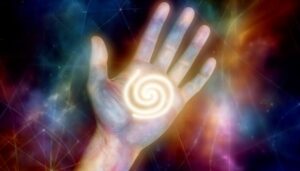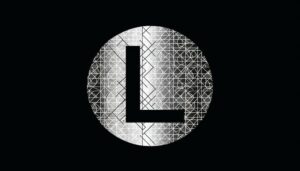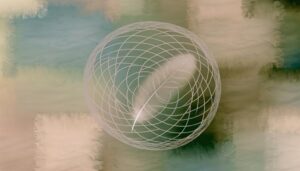What Is the Meaning of the Spiral Symbol in True Detective?
In 'True Detective,' the spiral symbol is a profound metaphor reflecting cyclical time and existential dread. Rooted in ancient cultures, spirals embody growth, rebirth, and cosmic patterns.
The show harnesses these meanings to illustrate the recurring nature of violence and moral decay. The spiral also visually represents the characters' psychological turmoil and entrapment in a relentless cycle of darkness.
Such usage is informed by mythological references, adding layers of thematic depth. This rich symbolism invites viewers to engage deeply with the philosophical underpinnings of the narrative and contemplate the complexities of human existence.
Exploring further will uncover additional insights.
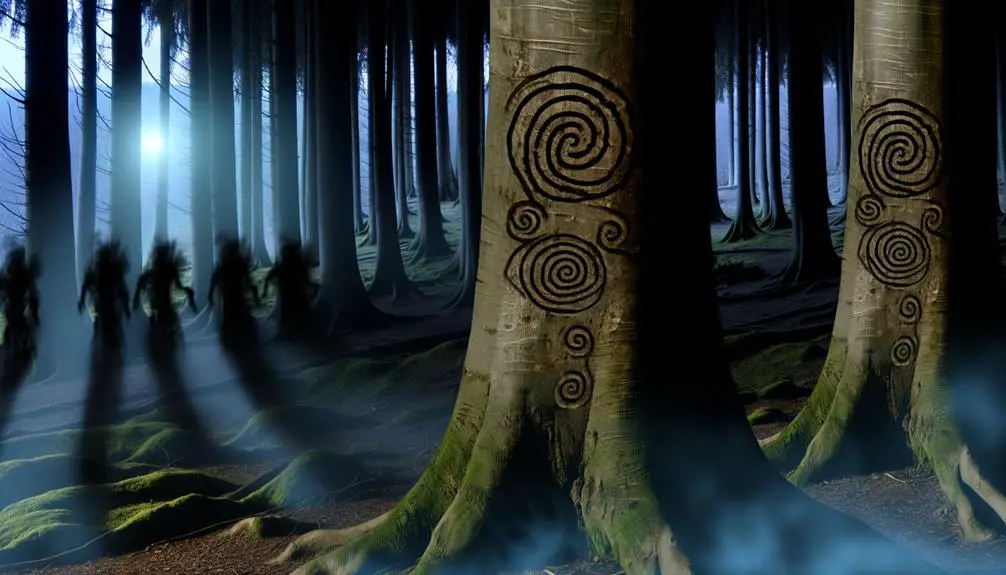
Key Takeaways
- The spiral symbol in 'True Detective' represents chaos and the cyclical nature of evil.
- It aligns with mythological references, emphasizing eternal return and existential dread.
- Spirals signify characters' entrapment in recurring violence and psychological unraveling.
- The symbol offers insights into the show's themes of time, morality, and human consciousness.
- It prompts deep reflection on life's cycles, enhancing the narrative's philosophical depth.
Historical Origins

The spiral symbol, with its historical roots spanning various ancient civilizations, has long been imbued with profound meanings and cultural significance. Archaeological evidence indicates the spiral's presence in early human art, particularly in Neolithic carvings and pottery.
These early manifestations were not mere decorations but encoded complex cosmological and metaphysical beliefs. The spiral often represented concepts of growth, evolution, and the cyclical nature of life. In some prehistoric contexts, it may have symbolized the path of the sun or celestial patterns.
Its recurrence in diverse cultures underscores a shared human inclination to understand the universe's cyclical rhythms. By analyzing these historical origins, one gains deeper insight into how the spiral symbol became a universal motif transcending temporal and geographical boundaries.
Symbolism in Ancient Cultures
Across various ancient cultures, the spiral symbol emerged as a potent emblem imbued with diverse interpretations and profound spiritual significance.
In Celtic traditions, spirals were often associated with the cycles of life, death, and rebirth, symbolizing a journey towards enlightenment.
The Greeks utilized the spiral in their architectural designs, epitomizing harmony and the infinite nature of the cosmos.
Indigenous Maori art features spirals to represent kinship and eternal connection to ancestors.
Meanwhile, in Hindu and Buddhist symbolism, spirals denote the unfolding of inner consciousness and the path to spiritual awakening.
Each culture's unique perspective underscores the spiral's universal resonance, reflecting humanity's quest to understand the mysteries of existence and the interconnectedness of all life.
The Spiral in True Detective
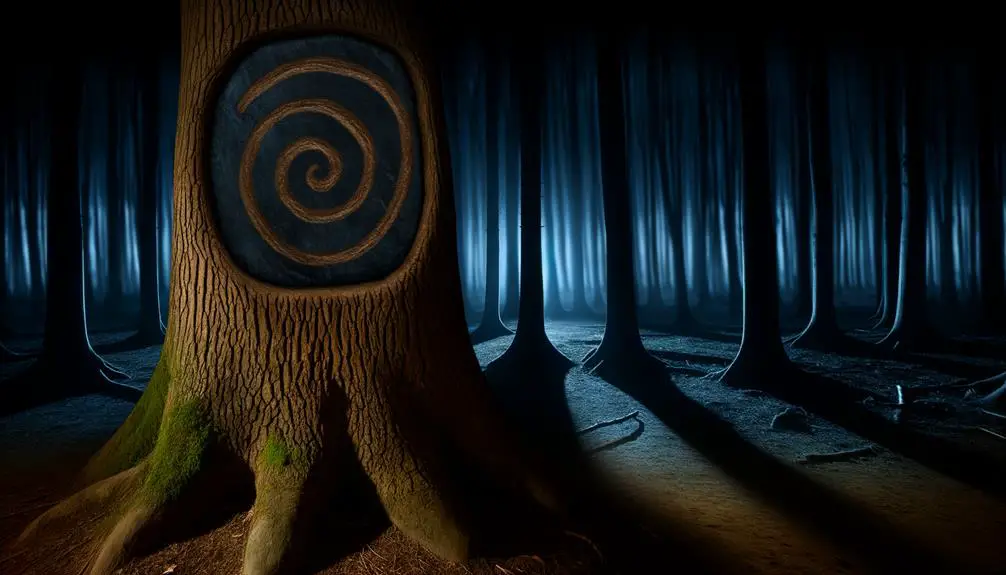
In True Detective, the spiral symbol functions as a multifaceted emblem, intertwining with themes from ancient mythology to signify chaos and cyclicality.
This potent image not only aligns with mythological references but also profoundly influences the narrative structure, driving the plot through an overarching sense of foreboding and interconnectedness.
Symbolic Representation Explained
Viewed through a lens of intricate symbolism, the spiral motif in True Detective encapsulates the series' exploration of cyclical time, existential dread, and the pervasive nature of evil.
The spiral, often found in crime scenes and referenced in dialogue, serves as a visual metaphor for the characters' entrapment in recurring patterns of violence and moral decay. This symbol underscores the show's philosophical musings on Nietzschean eternal recurrence, where events are doomed to repeat in an endless loop.
The spiral also evokes a sense of descent into madness, reflecting the protagonists' psychological unraveling as they explore deeper into the investigation. Ultimately, the spiral in True Detective is a powerful emblem of the inescapable grip of darkness and the human struggle against it.
Connection to Mythology
The spiral motif in True Detective not only serves as a symbol of cyclical time and existential dread but also draws deeply from ancient mythological traditions, where spirals often represent the labyrinthine journeys of heroes and the inescapable nature of fate. This symbolic imagery aligns with multiple mythological narratives, such as:
- The Labyrinth of Minos: Reflects the intricate, often perilous paths characters must navigate.
- Norse Mythology's Ouroboros: Symbolizes the eternal return and the cyclicality of existence.
- Celtic Spirals: Denote spiritual growth and the interconnectedness of life and death.
These mythological connections enrich the narrative, providing a profound, multi-layered understanding of the characters' existential struggles. By embedding these ancient symbols, True Detective taps into a universal archetype that resonates on a deep, almost primordial level.
Impact on Plot
As the spiral motif weaves through the narrative of True Detective, it serves as a critical plot device that underscores the characters' descent into chaos and their quest for meaning amidst the pervasive darkness. The spiral symbol emerges in pivotal moments, reflecting the protagonists' internal struggles and the cyclical nature of their investigation. This recurring motif deepens the thematic resonance, portraying the inescapable pull of past traumas and existential dread.
| Emotion | Character Impact | Plot Development |
|---|---|---|
| Dread | Rust's philosophical musings | Discovery of deeper horrors |
| Despair | Marty's personal conflicts | Unraveling of the conspiracy |
| Hope | Moments of clarity | Breakthroughs in the case |
| Intrigue | Audience engagement | Twists and revelations |
The spiral, in this manner, becomes a symbol of both entrapment and potential enlightenment.
Theories and Interpretations
Drawing from a myriad of cultural, historical, and symbolic frameworks, various theories have emerged to interpret the enigmatic spiral symbol featured prominently in True Detective. Scholars and enthusiasts alike have dissected its potential meanings, ranging from ancient mythological references to psychological interpretations.
The spiral can be seen as a metaphor for the cyclical nature of time and existence, encapsulating the series' exploration of human consciousness and morality. Additionally, it may signify:
- Spiritual Journeys: Reflecting transformation and enlightenment.
- Cosmic Patterns: Echoing the universe's infinite and complex structures.
- Psychological Depths: Representing the labyrinthine intricacies of the human mind.
These interpretations collectively enrich the narrative, offering profound insights into the show's thematic depth and philosophical underpinnings.
Visual Representation
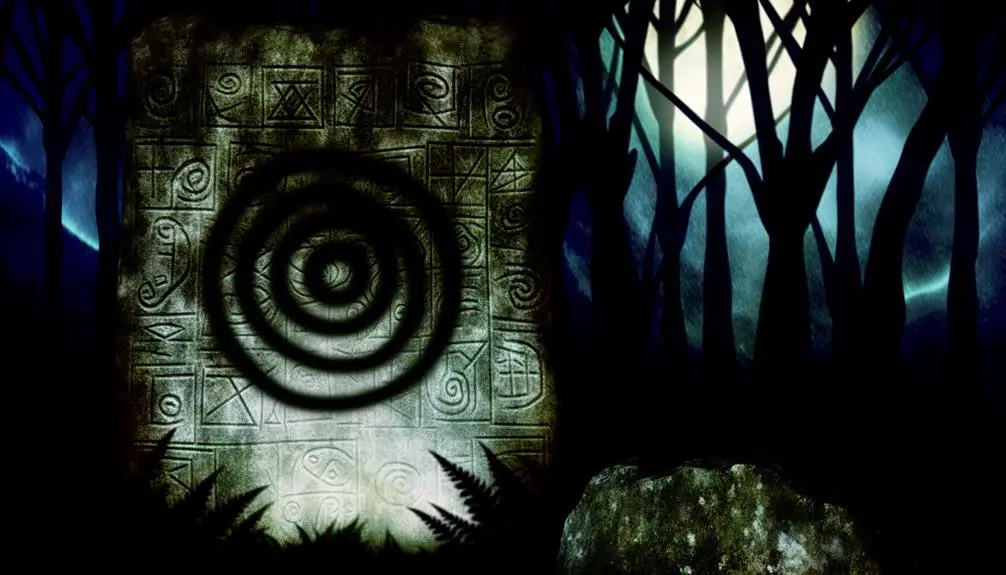
The visual representation of the spiral symbol in 'True Detective' serves as a multifaceted narrative device, embedding symbolic imagery that provokes analytical contemplation.
Examining the color and shape of the spiral, it becomes apparent that these elements are meticulously chosen to enhance the thematic depth and emotional resonance of the series.
Moreover, the symbol's cultural contexts and historical references enrich its significance, anchoring the story within a broader mythological and philosophical framework.
Symbolic Imagery Analysis
In the context of 'True Detective,' the spiral symbol serves as a potent visual metaphor that encapsulates the show's themes of cyclicality, chaos, and the inexorable pull of dark forces. This imagery functions as a recurring motif, reinforcing the narrative's exploration of human nature and existential dread. The spiral's form, ever tightening yet never reaching a conclusion, mirrors the characters' psychological descent and the story's nonlinear progression.
Through this symbol, 'True Detective' deftly intertwines visual and thematic elements, enhancing its complex storytelling.
- Cyclicality: The spiral reflects the repetitive nature of history and personal trauma.
- Chaos: Its irregular shape symbolizes disorder and the unpredictable nature of evil.
- Psychological Descent: The spiral visually represents the protagonists' journey into the depths of their own psyches.
Color and Shape Significance
Examining the interplay of color and shape in 'True Detective' reveals a deliberate use of visual elements to deepen the narrative's thematic resonance and emotional impact.
The recurring spiral symbol, often depicted in muted, earthy tones, evokes a sense of decay and cyclical violence. These colors, juxtaposed with the stark, geometric lines of urban landscapes, highlight the dichotomy between natural chaos and human order.
The spiral's continuous, unbroken form suggests an inescapability, reinforcing the series' exploration of fatalism. Additionally, the use of shadows and light contrasts within these shapes enhances the atmosphere of mystery and foreboding.
Such visual choices are not merely aesthetic but serve to underscore the psychological and existential depths of the storyline.
Cultural Contexts and References
Interpreting the spiral symbol within 'True Detective' requires an in-depth exploration of its diverse cultural contexts and historical references, which enhance its visual representation and thematic significance. The spiral motif is rich with symbolic meanings across various cultures, often embodying concepts of time, cyclical nature, and spiritual journeys.
In 'True Detective', it can be linked to:
- Ancient Celtic Art: Spirals in Celtic designs symbolize growth, expansion, and cosmic energy.
- Native American Petroglyphs: Representing life cycles and spiritual transformation.
- Greek Mythology: The labyrinth, akin to a spiral, denotes complex journeys and introspection.
These references collectively deepen the spiral's role in the narrative, enriching its symbolism and connecting it to broader human experiences and ancient traditions.
Philosophical Connections
The spiral symbol in 'True Detective' serves as a profound metaphor that intertwines with existentialist themes, reflecting the characters' struggles with the cyclical nature of human suffering and the search for meaning in a seemingly indifferent universe.
This symbol encapsulates the Sisyphean task faced by the protagonists, echoing the philosophical ideas of Nietzsche's eternal recurrence—where life endlessly repeats its events and struggles.
Additionally, the spiral evokes a sense of descent into chaos and madness, reminiscent of Camus's absurdism where individuals confront the inherent meaninglessness of life.
The labyrinthine structure of the spiral underscores the characters' journey through moral ambiguity and despair, ultimately questioning whether true resolution or understanding can ever be attained.
Impact on the Audience
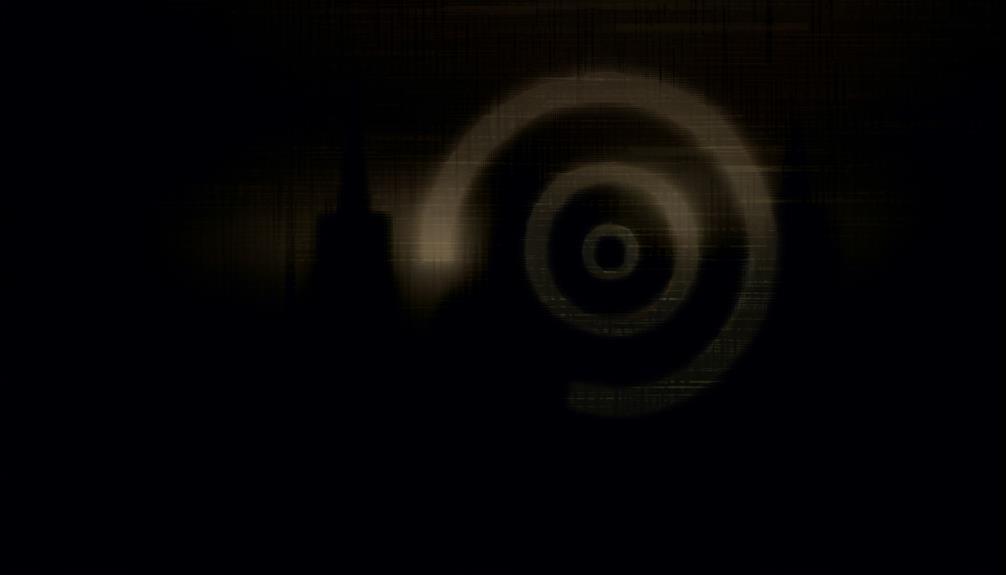
By embedding the spiral symbol within its narrative, 'True Detective' not only captivates viewers with its visual intrigue but also provokes deep reflection on the philosophical underpinnings of human existence and suffering. This symbol functions as a catalyst for audience engagement, prompting a deeper examination of life's cyclical nature and the pervasive influence of past trauma. The spiral becomes a focal point for:
- Exploring existential themes: Encouraging viewers to ponder the endless cycles of life and death.
- Enhancing narrative complexity: Adding layers to the plot that demand intellectual engagement.
- Eliciting emotional responses: Stirring feelings of unease and curiosity, fostering a more immersive viewing experience.
These impacts collectively elevate the series beyond mere entertainment, making it a profound psychological and philosophical exploration.
Conclusion
The spiral symbol in 'True Detective' serves as a profound narrative device, intertwining historical and cultural symbolism with contemporary storytelling.
Its intricate connections to ancient beliefs and philosophical concepts enrich the series' thematic depth and psychological complexity.
For instance, the use of the spiral in the Carcosa ritual scenes exemplifies how symbols can evoke powerful, archetypal fears and fascinations.
Such multi-layered symbolism not only enhances the audience's engagement but also invites deeper reflection on the universality of human experience.



